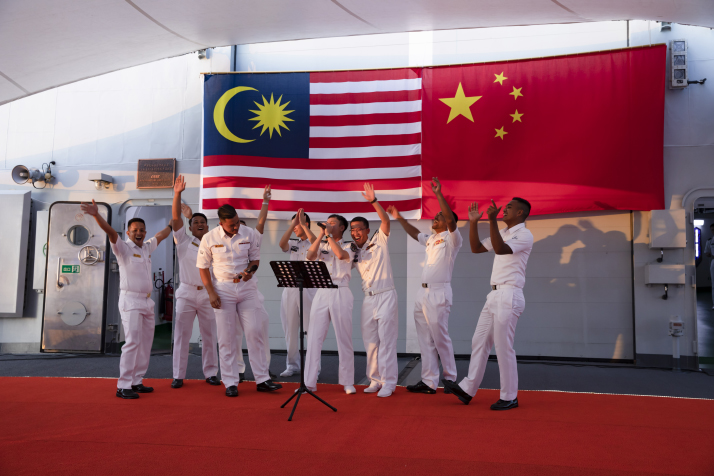| Voice |
| Taking the initiative | |
|
|
 Officers and soldiers of the Chinese Navy and the Royal Malaysian Navy sing together during a deck reception on the Chinese destroyer Nanning at Port Klang, Malaysia, on August 18. The 43rd Chinese Naval Escort Task Force had arrived at Port Klang for a four-day resupply the day before (XINHUA)
The growing traction of the Belt and Road Initiative (BRI), a China-proposed initiative to boost connectivity along and beyond the ancient Silk Road routes, across the world after a decade-long implementation is in itself a good testament to its relevance in current global governance. Though the unprecedented mega endeavor might be remembered for its pillar of infrastructure development, it remains a multidimensional initiative of connectivity boosted by five pillars in such areas as policy coordination, facilities connectivity, unimpeded trade, financial integration and people-to-people bonds. Over the years, the common quest for infrastructure development across the Global South did not make the BRI partnership a monopolistic privilege to the developing world. Neither would it signify the initiative is taking a back seat with the successive rollout of the China-proposed global initiatives—the Global Development Initiative (GDI), the Global Security Initiative (GSI) and the Global Civilizations Initiative (GCI). The BRI is there to stay albeit not without contestation and vicious vilification by its antagonists. The three initiatives, proposed by President Xi Jinping, aims to promote world peace, security, development and harmony. The GDI, announced in 2021 at the General Debate of the 76th Session of the United Nations General Assembly, aims to steer global development toward a new stage of balanced, coordinated and inclusive growth. The GSI, put forward in 2022 at the Boao Forum for Asia Annual Conference, stresses the importance of upholding a vision of common, comprehensive, cooperative and sustainable security. The GCI, calling for respect for the diversity of civilizations, was unveiled on March 15 in Beijing at the opening of the Communist Party of China in Dialogue with World Political Parties High-Level Meeting. Platform plurality In the latter case, all three Chinese global initiatives serve as useful enabling platforms for the BRI in the various turfs. The complementarity between the GDI and BRI in sustainable development is apparent when economic dividends are shared among countries embarking on specific initiatives in response to common developmental needs. Such a model of economic integration is now commonly undertaken through the various multilateral groupings that share the ideal of forging a community with a shared future for humanity. Meanwhile, the GSI provides a separate platform for partnering countries to address common challenges and priorities concertedly. Pressures ranging from extreme weather events to food and energy insecurities present the world with new, grave challenges that warrant a coherent and coordinated response from humanity. Much to the dismay of many, this is seriously lacking amid the waning global governance under the prevailing international order. Seemingly unrelated to the BRI, the GSI constitutes an alternative security architecture that allows policy coordination—one of the five pillars underpinning the BRI. It envisions a new indivisible security architecture that calls for common, comprehensive, cooperative and sustainable security characterized by a model of mutual respect, openness and integration. Its peace-driven nature is crucial in preparing a conflict-free environment that is conducive to the BRI's implementation. Against the current bleak international backdrop for nurturing sustainable peace, the GSI stands out as a stark contrast to the present conventional security architecture dominated by military alliances plus the presence and deployment of troops and weaponry on foreign soil. Given this backdrop, the GSI's promotion is understandably a daunting global task ahead. Parallel to this, the GCI pursues a no less challenging pathway vis-à-vis the GSI. It presents an inclusive model that allows for coexistence, interaction, mutual learning and appreciation between diverse cultures. This leaves no room for the prevailing cultural hegemony which has been taking shape through incessant dominance over the decades.  Staff of the Embassy of Fiji in China display the island country's traditional musical instrument at a cultural exhibition of participating countries of the Belt and Road Initiative in Beijing on September 2 (XINHUA)
Debunking the myths As the BRI has snowballed to its present size of 152 countries and 32 international organizations as of August, cultural differences rooted in civilizational disparity remain the No.1 challenge to confidence-building. Effective communication in the interest of promoting international understanding is necessary in the pursuit of coordinated cooperation across the globalized world. From the Chinese perspective, this would help pave a conducive ground for the BRI's continued expansion. Under a stream of disinformation regarding the BRI through international media, the GCI makes an ideal facilitator to dismantle cultural hegemony in the long run. What's more, the systemic isolation of and alienation against China courtesy of those same media outlets have never ceased to take a toll on the wafer-thin confidence across the globe. All in all, these narratives only serve the purpose of containing the meteoric rise of China. Amid the growing trust deficit across the world, they are playing a different ball game altogether in the realm of inter-nations communication. Prejudicial paranoia has distorted the truth and sensible thinking. By now, the United States-led West is virtually staging an all-out war of communication and perception against China on the world stage. Expansion of China's influence is made the bone of contention. Undoubtedly, the BRI and the three global initiatives are the key drivers instrumental in reshaping the global dynamics and paradigm. While the West is engrossed in pointing the finger at China's media as a "state-controlled tool" serving the purpose of propaganda, they cannot deny that their media is virtually controlled by a huge capital-based alliance, which serves the very interests of the military-industrial-media complex in the West. And this alliance is no stranger to disinformation directed against others. A case in point is the vilification of the BRI by labeling it as a "debt trap." This narrative has already been debunked and proven baseless with facts and figures from credible entities such as the Chatham House, a highly reputable British think tank. But to this day, the same lies are still being resurrected to serve their geopolitical purposes as and when necessary. In the face of a biased rhetoric and disinformation from the Western media and governments, China has to ramp up its worldwide communication to render itself better understood—from the right perspective. As the BRI and the global initiatives are usually analogized as a grand symphony in the Western narratives toward China, more civil societies and thinking individuals, notably from the Global South, should thus have their voices heard in countering the untruths with facts and figures. The trajectory of developing this into a global trend is no walk in the park. Growing pains are expected to accompany the bumpy road we are traveling. And it is only when more countries come to their senses after such a long reign of hegemony that we can be confident of the emergence of a new order that will underpin future global governance. The author is president of the Malaysian Belt and Road Initiative Caucus for the Asia-Pacific think tank Copyedited by Elsbeth van Paridon Comments to dingying@cicgamericas.com |
|
||||||||||||||||||||||||||||||
|